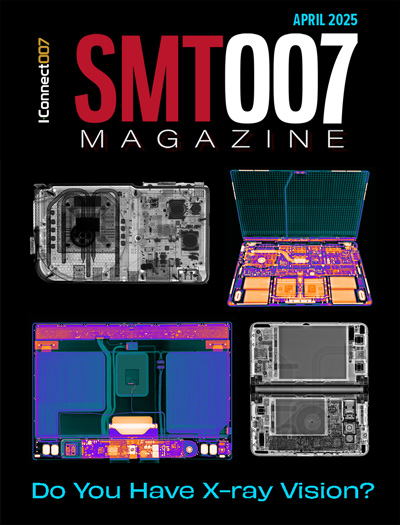-

- News
- Books
Featured Books
- smt007 Magazine
Latest Issues
Current Issue
Do You Have X-ray Vision?
Has X-ray’s time finally come in electronics manufacturing? Join us in this issue of SMT007 Magazine, where we answer this question and others to bring more efficiency to your bottom line.

IPC APEX EXPO 2025: A Preview
It’s that time again. If you’re going to Anaheim for IPC APEX EXPO 2025, we’ll see you there. In the meantime, consider this issue of SMT007 Magazine to be your golden ticket to planning the show.

Technical Resources
Key industry organizations–all with knowledge sharing as a part of their mission–share their technical repositories in this issue of SMT007 Magazine. Where can you find information critical to your work? Odds are, right here.
- Articles
- Columns
Search Console
- Links
- Media kit
||| MENU - smt007 Magazine
Open vs. Sealed Tubes in X-ray Inspection
December 31, 1969 |Estimated reading time: 5 minutes
A topic often discussed when assessing X-ray equipment capability is the configuration of an X-ray source characterized by open vs. sealed tube. This article explores the performance, reliability, maintenance, and operating costs attributed to each technology as it relates to non-destructive electronics inspection in the assembly market.
By Al Cabral
The population density of electronic devices within consumer, commercial, and computer products continues to increase - driven by the demand for smaller, more functional end products. One example is the continued integration and miniaturization of multifunctional handheld devices, such as combination cell phone/PDA/handheld PCs. On the other end of the printed circuit assembly spectrum, commercial computers and telecommunication boards also demand high use of real estate to provide increased functionality and performance.
As circuit board and component packaging real estate dwindles, it is anticipated that designers will continue to push fabrication limitations and bury an increasing number of electrical interconnections within the component footprint. Surface mount area-array packages such as BGAs, microBGAs, and chip-scale packages (CSPs) typically contain hundreds of hidden electrical connections, primarily located beneath component bodies, and typically in the form of metallic spheres. These package types are transitioning from tin/lead to tin/silver solder interconnects. Area-array packages present various challenges to each assembly, inspection, and test operation. Nowhere is this challenge more evident than in an inspection or verification process used to qualify solder interconnections - especially in the advent of lead-free processing.
X-ray inspection systems that used to qualify solder interconnections are evolving and being reconfigured with more powerful X-ray sources that can provide greater material penetration. Systems with <100-kV sources were once considered adequate; however, component evolution will almost certainly require >100 kV X-ray capability to peer through eminent component packages.
With regard to X-ray penetration, power, which is the product of some level of voltage and amperage, will increase to penetrate material density. Proportionally, an X-ray source’s spot size enlarges as increased power is applied, while regulating to prevent overheating and damage to the X-ray target. A secondary relationship should be considered when applying a combination of voltage and amperage; X-ray image resolution decreases as power is increased. A balance exists between applying sufficient power to penetrate a specific material, yet attaining the desired image resolution.
Figure 1 depicts the relationship between system magnification and field of view. As system magnification increases, field of view decreases.
 Figure 1. As system magnification increases, field of view decreases.
Figure 1. As system magnification increases, field of view decreases.
Key components of X-ray system magnification include the X-ray source to target distance, an X-ray detector (image intensifier or digital detector) to target distance, and camera zoom (analog or digital). A secondary relationship to consider when increasing magnification by increasing the total distance between the source and the detector is that additional power will be required and spot size will increase proportionally. Highlighting performance (X-ray image resolution), it has been claimed that the smaller the spot size, the higher the resolution. Although a smaller spot size will provide higher resolution, the application and the power required to penetrate the target must be considered. For example, typical plastic BGA 225s populated on a multi-layer PCB may require about 90 kV at 10 mA to capture a quality X-ray image with a corresponding spot size of about 10 µm vs. typical surface mount capacitors that may only require 50 kV at 5 mA with a spot size of about 5 µm. The argument of spot size related to open vs. sealed tube X-ray sources is a technical wash when applied to the inspection of SMT components and semiconductor packages. Instead, it is more of a consideration when inspecting silicon wafers.

In the arena of X-ray inspection, the topic of open vs. sealed tube X-ray source configuration emerges when assessing X-ray equipment capability (Table 1). Many interpretations have been given regarding open vs. sealed tubes in SMT assembly inspection. Sealed tubes typically provide longer uptime and more consistent image quality, while open tubes offer higher magnification and lower periodic maintenance costs. When comparing the characteristics of X-ray tubes, one first must place the application to be inspected in the forefront. When comparing electronic components such as BGAs against silicon wafers, for example, wafers or single-layer die may require higher magnification and are more easily penetrated than larger BGAs containing silicon plus non-metallic interposers, lead, tin, silver, copper, gold, and other materials.
Another consideration (one of operations logistics) when configuring an X-ray system’s source is how the system will be used, as well as the importance of system uptime and image repeatability. An X-ray system used for off-line failure analysis vs. continuous auditing may have the luxury of periodic machine-scheduled downtime to replace one of the X-ray’s components. It also may benefit from associated incremental operating costs offered by an open tube system - instead of a more expensive, one-time sub-system replacement of a sealed tube. An X-ray system being used for continuous auditing or inspection, operating in conjunction with a medium- to high-volume SMT line, may benefit from minimizing system downtime. It may be more suitable to configure such a system with a sealed tube that typically offers more than 10,000 hours of continuous operation with repeatable image quality.
Expanding on the maintenance aspect of an X-ray system, replacing an open-tube filament (a vital component of the X-ray source), and recalibrating the system, requires a higher skill set than replacing a self-contained, plug-and-play sealed X-ray unit. With regard to basic cost-of-ownership considerations between open vs. sealed X-ray tubes, equipment manufacturers should be consulted for actual repair frequencies and material costs. Machine productivity values, which in most cases will be higher than anticipated, are significant variables. Applying these specific values may prove to hedge one X-ray technology over the other, especially when considering system configurations from an operations perspective.
Conclusion
Configuring an X-ray inspection system with an open tube vs. a sealed tube X-ray source depends largely on the application and operation at hand. As part of most equipment evaluations, the selection process should include testing current products as well as representatives of future products. The relatively small investment in time may enlighten what you can or cannot see.
Al Cabral, product manager, VJ Electronix Inc., may be contacted at (978) 425-9446; e-mail: acabral@vjt.com.


